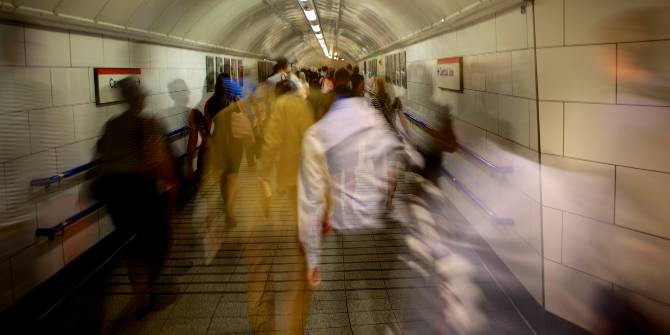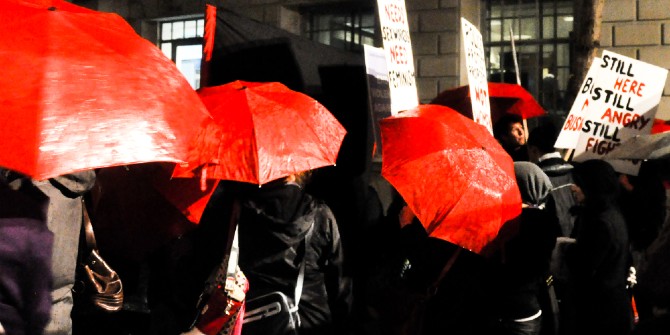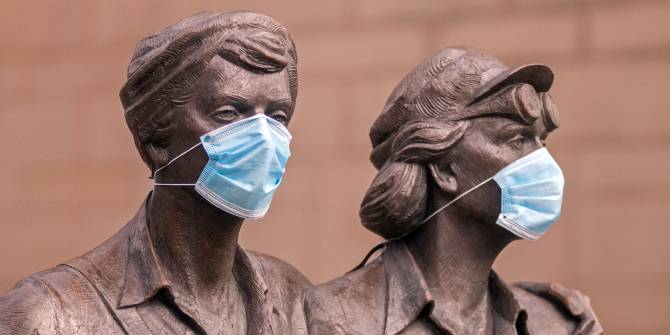Domestic violence rose during lockdown, but caseworkers have been overwhelmed and only a fraction of the support promised has arrived. Erika Lynn-Green (Harvard Medical School) talks to staff on the front line.
COVID-19 presents a deadly risk to women and girls in the UK, even those who will never contract it. The official pronouncements about policies intended to tackle domestic violence (DV) are unreliable, so the voices of frontline workers are essential for understanding the needs of DV survivors. The Guardian and the New York Times report that at least 26 women and girls have been murdered in acts of domestic violence since the beginning of the UK’s pandemic lockdown, more than triple the number who were killed in this period in 2019. Calls to the National Domestic Abuse Hotline increased 25% during the first two weeks of the lockdown alone. The UK government’s original pandemic plan on 3 March, however, included no mention of domestic violence.
Belatedly, Prime Minister Boris Johnson called a summit on domestic violence on 21 May, but a strategic action plan published by a coalition of DV advocacy agencies in the wake of the summit found that DV protections were still not factored into the government’s planning. Moreover, of the £37 million in emergency support pledged at that summit, the New York Times reported that only £1 million had arrived at frontline agencies by 2 July.

Has the government’s new focus changed the reality on the ground? Interviews in late July with two DV advocacy workers in London provide three key policy insights to improve support for DV survivors during the pandemic:
Lack of funding and inadequate staffing have made it impossible to provide adequate services
Safe Lives UK define a maximum caseload of 100 per year per full time caseworker in order to save lives, which means 25 cases at any given time based on length of service. During the pandemic, caseloads have regularly breached this limit. Betty and Anne (pseudonyms) both said that they were unable to meet the service standards of the agency such as weekly contact with each client, an updated risk assessment within 6 to 8 weeks, and same-day contact for new high-risk clients. Both their boroughs saw record numbers of referrals, nearing 250 new cases in June for one, and two and a half times normal volume for the other. Both workers held a caseload above the maximum, peaking at 32 and 40 cases in June.
Some cases, however, were too dangerous even to open, because the survivor only provided an email address (which the agency considers too risky without checking first who has access). As a result, one borough is keeping a spreadsheet of survivors who have to be contacted at some unknown later date. The recorded caseloads, therefore, are only the tip of the iceberg.
They described staffing shortages that represent serious, dangerous problems. Anne said her office did not get any more staff during the crisis, even with record referrals. Betty was transitioned from case work to full-time duty work (answering the helpline, responding to emails, doing intake risk assessments, and allocating cases) after her managers told her that she was needed for duty in part because of funding shortages that made it difficult to hire another person. But she was still holding 25 cases on the day of our interview, making her both a full-time case worker and a full-time duty worker. Neither interviewee knew of any government funding that had reached their organisation, instead describing steps that the organisation itself had made to raise “thousands of pounds” from the public and make that money available to service users. The staffing and workload strain put the lives of women and girls at risk, which is reflected in the statistics.
Survivors need more economic and housing support, as well as DV advocacy
The interviewees said service users had been forced to make choices that endangered their safety due to the economic squeeze, especially with regards to housing. Betty said that a number of her service users, facing housing insecurity, chose to live with their perpetrator instead of their parents for fear of exposing the latter to coronavirus. Survivors living with their perpetrators and told not to go outside are physically and constantly closer to potential violence. Seeking help is all the harder
“if the perpetrator is in the room watching you or perhaps through the window and seeing what you’re doing.”
Anne said that while at the beginning of lockdown she was able to house more people than she normally would because of emergency measures, their refuges were now all full, including the COVID-era emergency refuge set up rapidly after lockdown. Anne suggested that more emergency COVID-19 hostels with fewer eligibility requirements (e.g. risk level, presence of children) than the standard women’s refuges should be set up, because more of her service users would be able to access them.
Many of their clients had been put on furlough. This situation put normal casework tools with associated costs such as injunctions or counselling, as well as daily necessities, out of reach for many of them. Betty said that she was able to apply for an agency-wide emergency COVID fund that “gives service users themselves £30 and £15 for each child… for groceries or something like that,” but not financial support beyond this point. This level of financial insecurity makes the prospect of fleeing housing due to violence much more difficult, and exposes them to more violence.
Children have been greatly affected
Workers in the Violence Against Women and Girls (VAWG) sector have still not been designated as essential key workers, and so they cannot go into the office or see service users in person at all. This lack of face-to-face contact is more than inconvenient: sometimes service users cannot call or text from their homes because their perpetrator is watching them. DV workers are also unable to be co-located in Children’s Social Care (CSC) at the moment. Anne said
“They [Children’s Social Care] are only doing home visits for the really high risk. So they’re doing video calls in the home, for example, and talking to children on Zoom and talking to mums on the computer, but of course you can’t get a proper sense that way.”
During the first month of lockdown, there was no system by which CSC and their DV agency could even see each others’ cases. Betty and Anne described a system where children’s safeguarding was on the backburner, where decreased social worker visits, a lack of colocation, and delays in integrating systems meant that children at risk of DV were not being screened.
Legislation proposing a dilution of CSC and Ofsted oversight has been proposed and rejected three times since 2016. However, secondary legislation that came into force on 24 April 2020 (the Adoption and Children (Coronavirus) (Amendment) Regulations) did just that. A sector-wide report concludes that the pandemic has been used as “an opportunity for deregulation of children’s social care, with neither the scrutiny of Parliament nor stakeholders”. The second version of this bill came into force on 25 September 2020, also under negative procedure with no parliamentary vote. It allows CSC to conduct in-person visits if not contrary to Public Health England guidance on COVID-19, alongside virtual visits “where appropriate.” Ofsted oversight visits continue to be suspended until March 2021.
Funding is woefully inadequate
The DV agency where both interviewees work is a charity, but relied upon by the government to implement their anti-VAWG strategy in the boroughs where they work. Refuge UK noted in the sector-wide report that the £37 million emergency allocation (again, of which only about £1 million is known to have reached agencies) is only about half of what the sector needs in order to keep their service standards high and women and girls safe.
Every organisation and government around the world had to make rapid, unplanned changes in the face of the pandemic, and understandably those transitions were imperfect. Betty and Anne both framed their suggestions in terms of the next few months. Economic and housing support clearly intersect with the needs of survivors as the emergency continues. To keep women and children safe in the UK, the sector urgently needs more funding for increased staffing levels, economic and housing support for survivors, and careful attention to the intersecting needs of children during the pandemic.
This post represents the views of the author and not the COVID-19 blog, nor LSE.





Thank you for this excellent article and research highlighting the hidden lethality of this pandemic. I am sure similar terror is happening in the United States. It would certainly help if social work training was subsidized by the government so we had many, many more helpers and a system that could adequately support those in desperate situations.